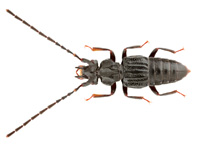Abstract
An assessment was performed regarding the accuracy of various types of data deposited in the Barcode of Life Data system (BOLD) related to the true bug family Cydnidae (Hemiptera: Heteroptera). Taxonomic nomenclature and classification, identification reliability, and the correctness of the data provided in the “Taxon description” were analyzed and commented on with respect to both available versions of the BOLD system, i.e. version 3 and beta version 4. Numerous mistakes in taxonomy, the relevance of the taxa names, and species misidentifications in BOLD version 3 were found and, more importantly, similar errors were detected in BOLD version 4 as well. We suggest that if the BOLD system is presumed to be taxonomically trustworthy, it can’t exist without an adequate a priori identification of barcoded specimens. Otherwise, the erroneous data deposited onto the BOLD platform will have a negative impact on studies in which molecular data imported from BOLD are utilized.
References
Bortolus, A. (2008) Error cascades in the biological sciences: the unwanted consequences of using bad taxonomy in ecology. Ambio, 37, 114–118.
http://dx.doi.org/10.1579/0044-7447(2008)37[114:ECITBS]2.0.CO;2Collins, R.A. & Cruickshank, R.H. (2013) The seven deadly sins of DNA barcoding. Molecular Ecology Resources, 13, 969–975.
Ebach, M.C. & Holdrege, C. (2005) More taxonomy, not DNA barcoding. Bioscience, 55, 822–823.
http://dx.doi.org/10.1641/0006-3568(2005)055[0823:MTNDB]2.0.CO;2Froeschner, R.C. (1960) Cydnidae of the Western Hemisphere. Proceedings of the United States National Museum, 111, 337–680.
http://dx.doi.org/10.5479/si.00963801.111-3430.337Hajibabaei, M., Singer, G.A.C., Clare, E.L. & Hebert, P.D.N. (2007a) Design and applicability of DNA arrays and DNA barcodes in biodiversity monitoring. BMC Biology, 5, 24.
http://dx.doi.org/10.1186/1741-7007-5-24Hajibabaei, M., Singer, G.A., Hebert, P.D. & Hickney, D.A. (2007b) DNA barcoding: how it complements taxonomy, molecular phylogenetics and population genetics. Trends in Genetics, 23, 167–172.
Harris, D.J. (2003) Can you bank on GenBank? Trends in Ecology and Evolution, 18, 317–319.
Hebert, P.D.N., Cywinska, A., Ball, S.L. & deWaard, J.R. (2003) Biological identifications through DNA barcodes. Proceedings of the Royal Society London B, 270, 313–321.
http://dx.doi.org/10.1098/rspb.2002.2218Jinbo U., Kato, T. & Ito, M. (2011) Current progress in DNA barcoding and future implications for entomology. Entomological Science Entomological Science, 14, 107–124.
http://dx.doi.org/10.1111/j.1479-8298.2011.00449.xKress, W.J., García-Robledo, C., Uriarte, M. & Erickson, D.L. (2015) DNA barcodes for ecology, evolution, and conservation. Trends in Ecology and Evolution, 30, 25–35.
http://dx.doi.org/10.1016/j.tree.2014.10.008Lal, D. & Lal, R. (2011) Wrong sequences in databases: whose fault? Indian Journal of Microbiology, 51, 413.
Linnavuori, R.E. (1993) Cydnidae of west, central and north-east Africa (Heteroptera). Acta Zoologica Fennica, 192, 1–148.
Lis, B., Lis, J.A. & Ziaja, D.J. (2013) Identification of the nymphal stages of two European seed bugs, L. equestris and L. simulans (Hemiptera: Heteroptera: Lygaeidae), using DNA barcodes. Zootaxa, 3608 (2), 147–150.
http://dx.doi.org/10.11646/zootaxa.3608.2.5Lis, J.A. (1994) A revision of Oriental burrower bugs (Heteroptera: Cydnidae). Upper Silesian Museum, Bytom, 349 pp.
http://dx.doi.org/10.13140/RG.2.1.1688.5847Lis, J.A. (1999a) Taxonomy and phylogeny of Cephalocteinae with a reference to their biogeography (Hemiptera: Heteroptera: Cydnidae). Polish Journal of Entomology, 68, 111–131.
Lis, J.A. (1999b) Burrower bugs of the Old World – a catalogue (Hemiptera: Heteroptera: Cydnidae). Genus (Wrocław), 10, 165–249.
Lis, J.A. (2006) Cydnidae Billberg, 1820 – burrowing bugs (burrower bugs). In: Aukema, B. & Rieger, Chr. (Eds.), Catalogue of the Heteroptera of the Palaearctic Region. Vol. 5. Pentatomomorpha II. The Netherlands Entomological Society, Wageningen, pp. 119–147.
Lis, J.A. & Lis, B. (2011) Is accurate taxon identification important for molecular studies? Several cases of faux pas in pentatomoid bugs (Hemiptera: Heteroptera: Pentatomoidea). Zootaxa, 2932, 47–50.
Meiklejohn, K.A., Wallman, J.F. & Dowton, M. (2013) DNA barcoding identifies all immature life stages of a forensically important flesh fly (Diptera: Sarcophagidae). Journal of Forensic Sciences, 58, 184–187.
http://dx.doi.org/10.1111/j.1556-4029.2012.02220.xNakano, A. & Honda, J. (2015) Use of DNA sequences to identify forensically important fly species and their distribution in the coastal region of Central California. Forensic Science International, 253, 1–13.
http://dx.doi.org/10.1016/j.forsciint.2015.05.001Ratnasingham, S. & Hebert, P.D.N. (2007) BOLD: The Barcode of Life Data System (www.barcodinglife.org). Molecular Ecology Notes, 7, 355–364.
http://dx.doi.org/10.1111/j.1471-8286.2007.01678.xSantos, A.M. & Branco, M. (2012) The quality of name-based species records in databases. Trends in Ecology and Evolution, 27, 6–7.
http://dx.doi.org/10.1016/j.tree.2011.10.004Santos, L.M. & Faria, L.R.R. (2011). The taxonomy’s new clothes: a little more about the DNA-based taxonomy. Zootaxa, 3025, 66–68.
Suresh Kumar, U., Ratheesh, R.V., Thomas, G. & George, S. (2012) Use of DNA barcoding in wildlife forensics: a study of sambar deer (Rusa unicolor). Forest Science and Technology, 8, 224–226.
http://dx.doi.org/10.1080/21580103.2012.750802Valentini, A., Pompanon, F. & Taberlet, P. (2009) DNA barcoding for ecologists. Trends in Ecology and Evolution, 24, 110–117.
http://dx.doi.org/10.1016/j.tree.2008.09.011Vivien, R., Wyler, S., Lafont, M. & Pawlowski, J. (2015) Molecular barcoding of aquatic oligochaetes: implications for biomonitoring. PLoS ONE, 10 (4), e0125485.
http://dx.doi.org/10.1371/journal.pone.0125485Yan, D., Luo, J.Y., Han, Y.M., Peng, C., Dong, X.P., Chen, S.L., Sun, L.G. & Xiao, H.X. (2013) Forensic DNA Barcoding and Bio-Response Studies of Animal Horn Products Used in Traditional Medicine. PLoS ONE, 8 (2), e55854.
http://dx.doi.org/10.1371/journal.pone.0055854

